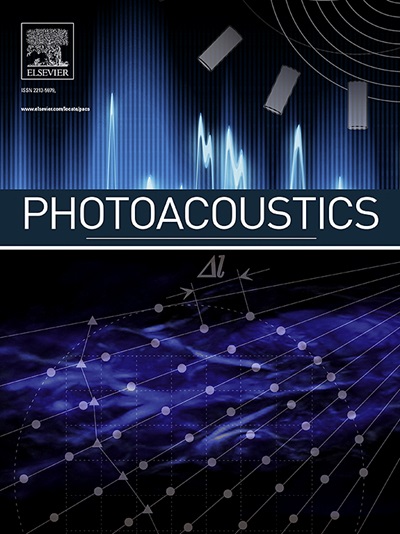压缩光声显微镜稀疏扫描编码与神经网络解码
IF 6.8
1区 医学
Q1 ENGINEERING, BIOMEDICAL
引用次数: 0
摘要
光声显微镜(PAM)提供高分辨率,非侵入性和无标签成像,使其对生物医学研究非常宝贵。然而,缓慢的数据采集和高采样要求仍然是限制其更广泛的适用性和可扩展性的关键挑战。我们提出了一种信息高效光声显微镜(IE-PAM),它联合集成了稀疏扫描编码和神经网络解码,以从极其有限的测量中实现高质量的重建。具体而言,IE-PAM采用随机二值掩模引导的稀疏扫描采集方案,并使用AFDU-Net(一种定制设计的基于全采样地面真值数据训练的神经解码器)重建高保真图像。我们的系统可以忠实地恢复详细的解剖结构,只需1.5 %的全采样率,相当于采集效率提高了66倍以上。在小鼠耳血管的体内实验中,IE-PAM在不同采样率下的精细血管保真度、伪像抑制和鲁棒性方面优于传统和基于学习的基线。通过最大限度地减少采集阶段的信息冗余,并从最少的数据中实现准确的重建,IE-PAM为临床前和研究应用中高效、快速和可扩展的光声成像提供了基础。本文章由计算机程序翻译,如有差异,请以英文原文为准。
Sparse scanning encoding and neural network decoding for compressed photoacoustic microscopy
Photoacoustic microscopy (PAM) offers high-resolution, non-invasive, and label-free imaging, making it invaluable for biomedical research. However, slow data acquisition and high sampling requirements remain key challenges that limit its broader applicability and scalability. We propose an Information-Efficient Photoacoustic Microscopy (IE-PAM) that jointly integrates sparse scanning encoding with neural network decoding to achieve high-quality reconstruction from extremely limited measurements. Specifically, IE-PAM employs a sparse-scanning acquisition scheme guided by random binary masks and reconstructs high-fidelity images using AFDU-Net, a custom-designed neural decoder trained on fully sampled ground truth data. Our system can faithfully recover detailed anatomical structures from as little as 1.5 % of the full sampling rate, corresponding to more than a 66-fold increase in acquisition efficiency. In in-vivo experiments on mouse ear vasculature, IE-PAM outperforms both traditional and learning-based baselines in fine vascular fidelity, artifact suppression, and robustness across varying sampling rates. By minimizing information redundancy at the acquisition stage and enabling accurate reconstruction from minimal data, IE-PAM provides a foundation for efficient, fast and scalable photoacoustic imaging in both preclinical and research applications.
求助全文
通过发布文献求助,成功后即可免费获取论文全文。
去求助
来源期刊

Photoacoustics
Physics and Astronomy-Atomic and Molecular Physics, and Optics
CiteScore
11.40
自引率
16.50%
发文量
96
审稿时长
53 days
期刊介绍:
The open access Photoacoustics journal (PACS) aims to publish original research and review contributions in the field of photoacoustics-optoacoustics-thermoacoustics. This field utilizes acoustical and ultrasonic phenomena excited by electromagnetic radiation for the detection, visualization, and characterization of various materials and biological tissues, including living organisms.
Recent advancements in laser technologies, ultrasound detection approaches, inverse theory, and fast reconstruction algorithms have greatly supported the rapid progress in this field. The unique contrast provided by molecular absorption in photoacoustic-optoacoustic-thermoacoustic methods has allowed for addressing unmet biological and medical needs such as pre-clinical research, clinical imaging of vasculature, tissue and disease physiology, drug efficacy, surgery guidance, and therapy monitoring.
Applications of this field encompass a wide range of medical imaging and sensing applications, including cancer, vascular diseases, brain neurophysiology, ophthalmology, and diabetes. Moreover, photoacoustics-optoacoustics-thermoacoustics is a multidisciplinary field, with contributions from chemistry and nanotechnology, where novel materials such as biodegradable nanoparticles, organic dyes, targeted agents, theranostic probes, and genetically expressed markers are being actively developed.
These advanced materials have significantly improved the signal-to-noise ratio and tissue contrast in photoacoustic methods.
 求助内容:
求助内容: 应助结果提醒方式:
应助结果提醒方式:


